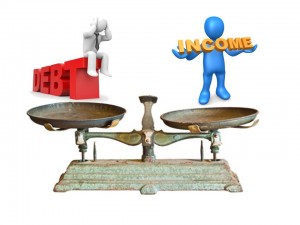Debt to Income Ratio Calculator
If you are trying to get a loan or a line of credit you may want to check your DTI with an online debt to income ratio calculator. What is DTI? It stands for debt to income ratio and it is a major factor when banks decide on whether to give you a loan. Debt to income ratio calculators are found all over the web or you just plug your numbers into this formula. D / I=%
D—Stands for Debt.
For this equation, ‘debt’ includes all of your recurring monthly payments. Add up all of your housing costs first. If you own a house include your mortgage, insurance, property taxes, and homeowner’s association dues. If you rent you just have to add that number. Next add your credit card payments (just include the minimum because that’s all you have to pay), then add car payment, student loans, judgments, and other credit based payments.
I—Stands for Income.
Use your gross monthly income.%–is the product of dividing these numbers. The numbers will come out as a decimal like .25, all you do is move the decimal over to the right 2 places or multiple it by 100 to get a percentage; in this case 25%.
These are also how you come up with the numbers to enter into a debt to income calculator. Some debt to income calculators only count your housing expenses as your debt, this is called a front-end debt calculation. Other debt to income calculators use your entire debt amount, this is called back-end debt. Banks use this number to determine how likely you are to pay back a loan.
Computing for Debt to Income Ratio
Here’s an Example of Debt to Income Ratio
Ben makes $7,000 a month
He lives in a $2,000 a month apartment
He drives a car that costs $500 a month
His credit card minimum payments are $500
His student loan costs $200
His front end debt in only $2,000; but his back end debt is $3,200. Ben can enter these numbers into a debt to income ratio calculator or he can do this easy calculation on his own (every smartphone has a calculator). He will divide $3,200 by $7,000 and get .46—move the decimal and it’s 46%.
Most banks recommend a debt to income ratio of 36%. What can Ben do is to lower his percentage? Experts recommend making extra payments to lower your credit card debt (thereby lowering the minimum payment). He could drive a less expensive car or live in a less expensive apartment. Ben also has the option of increasing his monthly income to lower his percentage.
Importance of Knowing Your Debt to Income Ratio
This number is just as important as your credit score because it tells lenders how responsible you are. Some debt is good, but excessive debt and a high DTI tells potential creditors that you might not make enough money to pay them back. Credit score tells potential creditors whether you’ve paid your bills on time; so these 2 numbers together tell the bank if you have enough money to pay loans or credit cards back AND whether you are consciences enough to pay your bills every month.
It is important to know your debt to income ratio if you are buying a car or any purchase that ends up being a recurring monthly payment. Experts suggest saving and paying cash for large purchases instead of adding to your debt. If you are working to pay down your debt, check your DTI often. Seeing the percentage drop will motive you to keep shrinking your debt.
Ben from our example has a high DTI; he is surely feeling a financial squeeze and he has to take action before his debt becomes way out of control. The debt to income ratio calculator can also be used in the opposite way to see what amount of debt would be manageable on Ben’s income.
Ben wants his DTI to land right about 36%. So he converts 36% into a decimal .36 and multiplies it by his monthly income of $7,000. The result is $2,520. Ben needs to shave $680 off his debt. He can take a little bit from everywhere and he will barely feel it. Ben will feel the grip of debt loosening and he will breathe easier.
Using a debt to income calculator will give you a better picture of your financial situation; plus you will discover one of the numbers that the banks are using to evaluate you.







Speak Your Mind